Contemporary Development in Business and Management: TSB Report
VerifiedAdded on 2020/05/16
|19
|5135
|211
Report
AI Summary
This report provides an executive summary and detailed analysis of TSB Banking Group PLC, a major retail and commercial bank in the United Kingdom. It examines the effects of external environmental factors, including legal, economic, political, environmental, socio-cultural, and technological factors, on the bank's operations. The report utilizes the LE PEST C framework to assess these influences. Furthermore, it investigates the competitive dynamics within the UK banking industry and their impact on TSB's strategies and decision-making processes. The report defines competitive dynamics and discusses their relevance. The report also assesses the effectiveness of TSB Banking Group PLC's responses to these challenges and offers recommendations for improvements, concluding with a comprehensive overview of the bank's performance within the dynamic UK banking landscape.
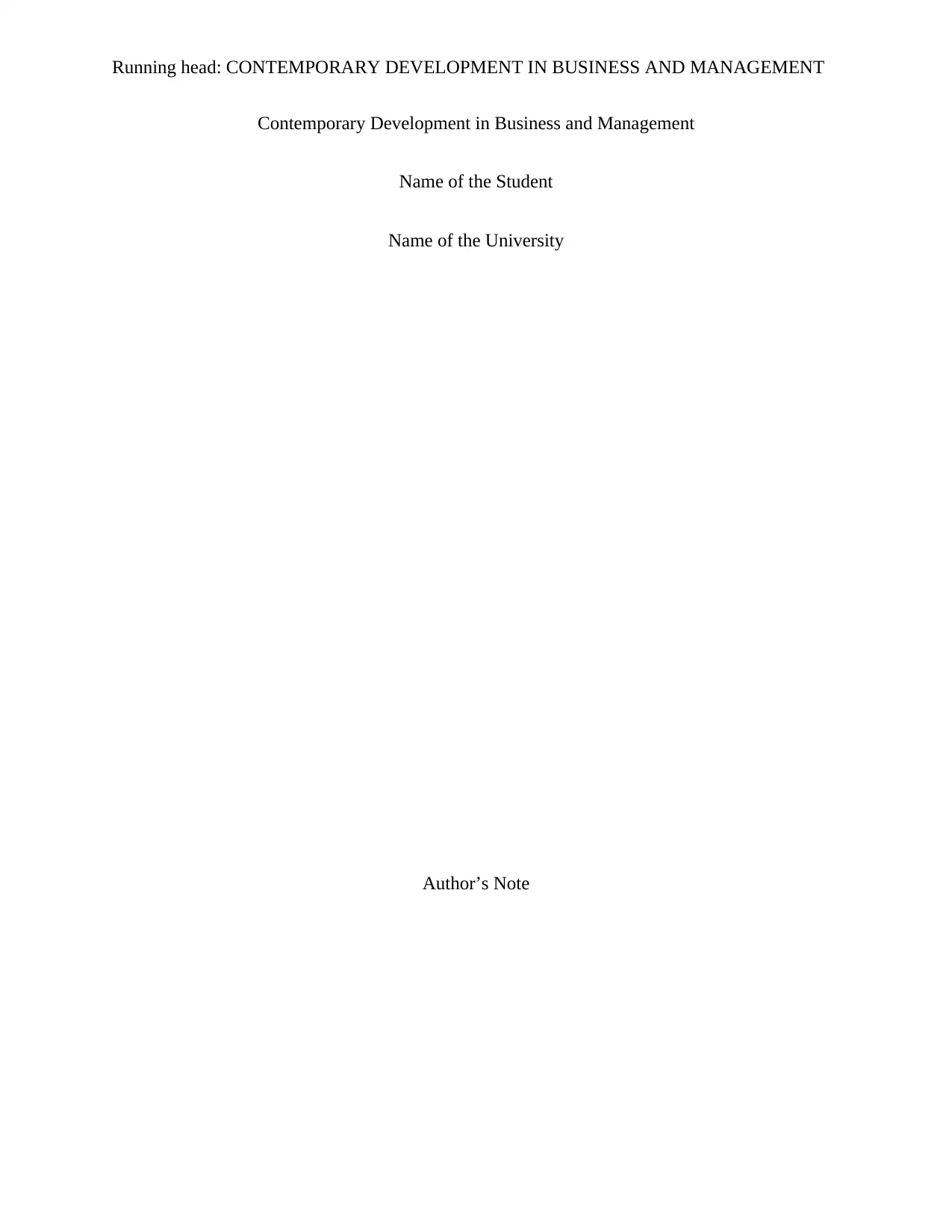
Running head: CONTEMPORARY DEVELOPMENT IN BUSINESS AND MANAGEMENT
Contemporary Development in Business and Management
Name of the Student
Name of the University
Author’s Note
Contemporary Development in Business and Management
Name of the Student
Name of the University
Author’s Note
Paraphrase This Document
Need a fresh take? Get an instant paraphrase of this document with our AI Paraphraser
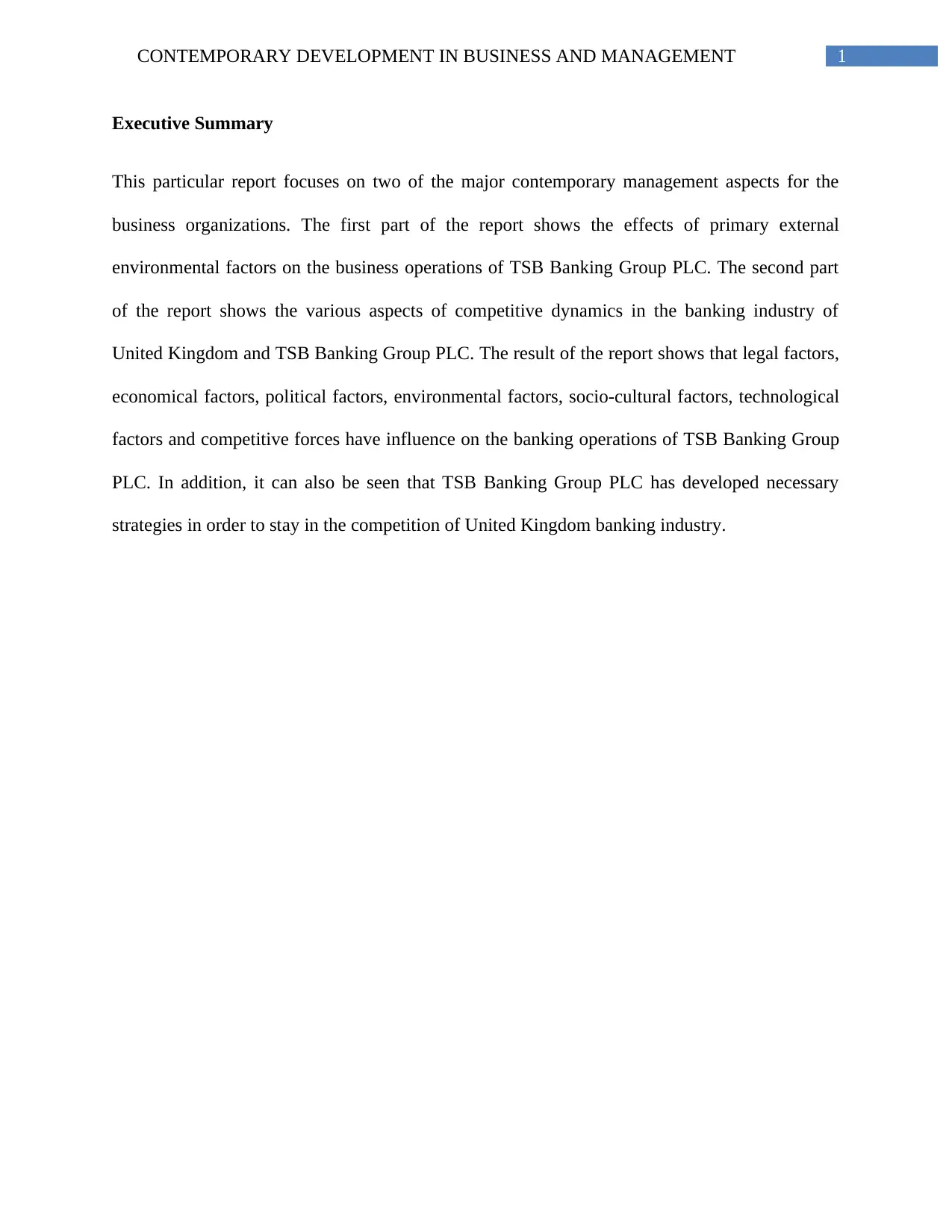
1CONTEMPORARY DEVELOPMENT IN BUSINESS AND MANAGEMENT
Executive Summary
This particular report focuses on two of the major contemporary management aspects for the
business organizations. The first part of the report shows the effects of primary external
environmental factors on the business operations of TSB Banking Group PLC. The second part
of the report shows the various aspects of competitive dynamics in the banking industry of
United Kingdom and TSB Banking Group PLC. The result of the report shows that legal factors,
economical factors, political factors, environmental factors, socio-cultural factors, technological
factors and competitive forces have influence on the banking operations of TSB Banking Group
PLC. In addition, it can also be seen that TSB Banking Group PLC has developed necessary
strategies in order to stay in the competition of United Kingdom banking industry.
Executive Summary
This particular report focuses on two of the major contemporary management aspects for the
business organizations. The first part of the report shows the effects of primary external
environmental factors on the business operations of TSB Banking Group PLC. The second part
of the report shows the various aspects of competitive dynamics in the banking industry of
United Kingdom and TSB Banking Group PLC. The result of the report shows that legal factors,
economical factors, political factors, environmental factors, socio-cultural factors, technological
factors and competitive forces have influence on the banking operations of TSB Banking Group
PLC. In addition, it can also be seen that TSB Banking Group PLC has developed necessary
strategies in order to stay in the competition of United Kingdom banking industry.
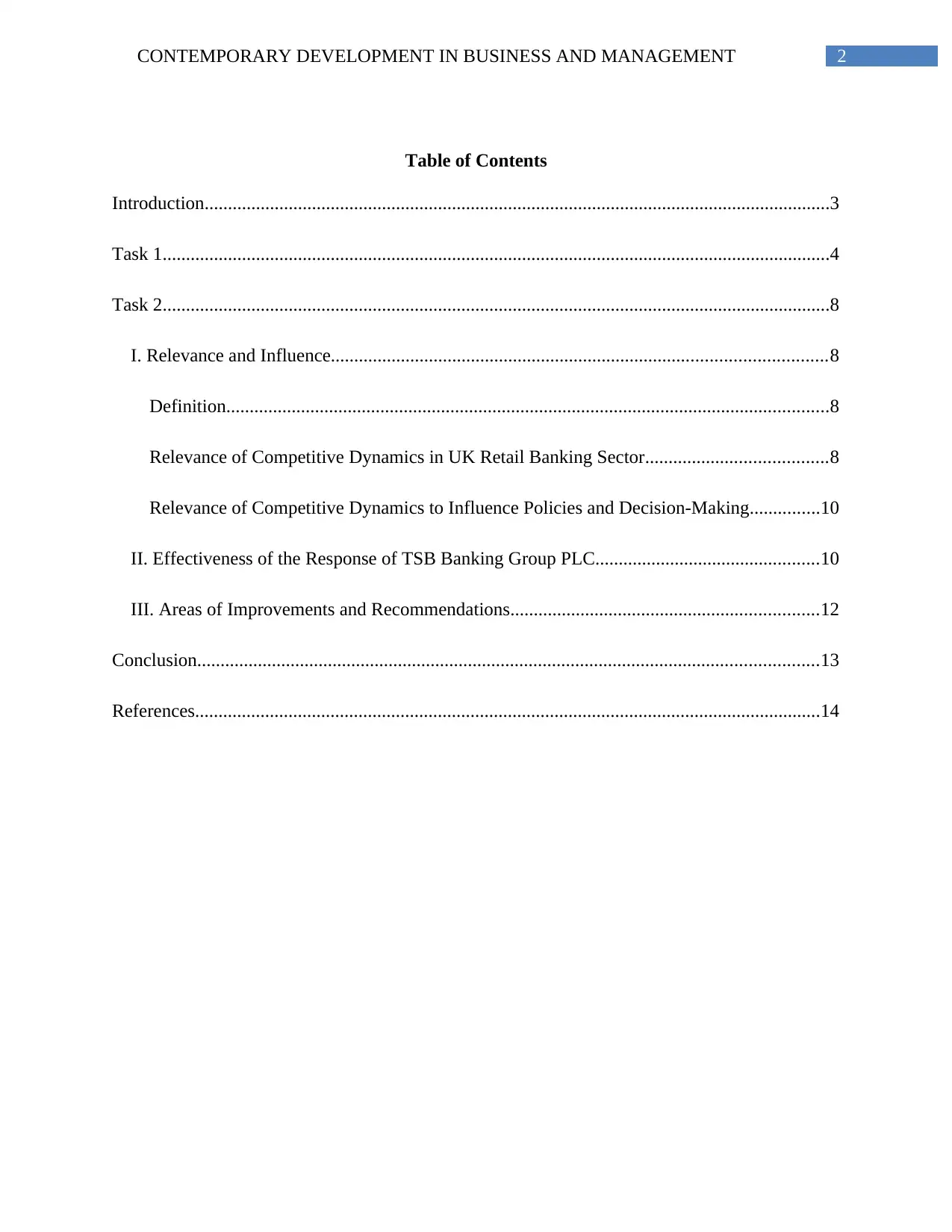
2CONTEMPORARY DEVELOPMENT IN BUSINESS AND MANAGEMENT
Table of Contents
Introduction......................................................................................................................................3
Task 1...............................................................................................................................................4
Task 2...............................................................................................................................................8
I. Relevance and Influence..........................................................................................................8
Definition.................................................................................................................................8
Relevance of Competitive Dynamics in UK Retail Banking Sector.......................................8
Relevance of Competitive Dynamics to Influence Policies and Decision-Making...............10
II. Effectiveness of the Response of TSB Banking Group PLC................................................10
III. Areas of Improvements and Recommendations..................................................................12
Conclusion.....................................................................................................................................13
References......................................................................................................................................14
Table of Contents
Introduction......................................................................................................................................3
Task 1...............................................................................................................................................4
Task 2...............................................................................................................................................8
I. Relevance and Influence..........................................................................................................8
Definition.................................................................................................................................8
Relevance of Competitive Dynamics in UK Retail Banking Sector.......................................8
Relevance of Competitive Dynamics to Influence Policies and Decision-Making...............10
II. Effectiveness of the Response of TSB Banking Group PLC................................................10
III. Areas of Improvements and Recommendations..................................................................12
Conclusion.....................................................................................................................................13
References......................................................................................................................................14
⊘ This is a preview!⊘
Do you want full access?
Subscribe today to unlock all pages.

Trusted by 1+ million students worldwide
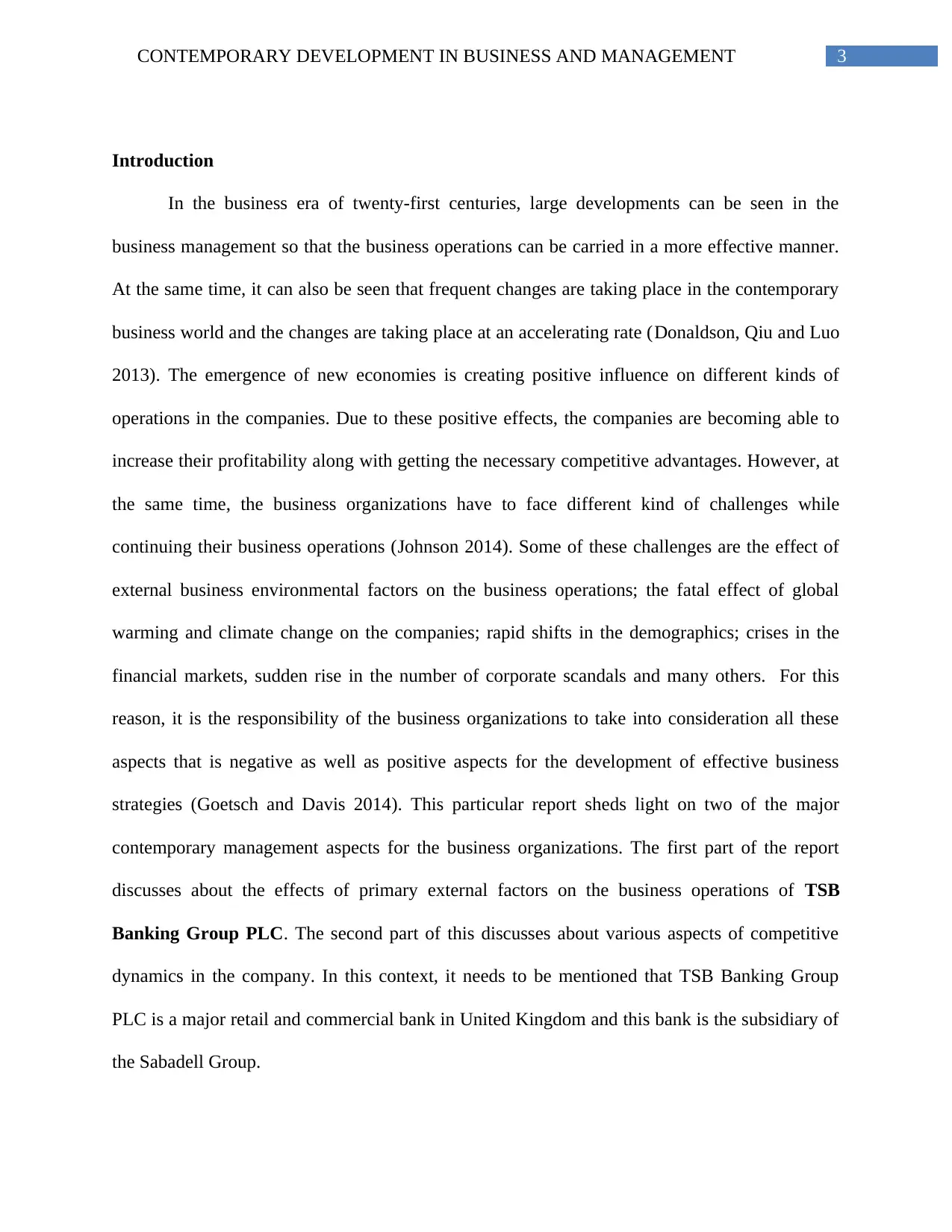
3CONTEMPORARY DEVELOPMENT IN BUSINESS AND MANAGEMENT
Introduction
In the business era of twenty-first centuries, large developments can be seen in the
business management so that the business operations can be carried in a more effective manner.
At the same time, it can also be seen that frequent changes are taking place in the contemporary
business world and the changes are taking place at an accelerating rate (Donaldson, Qiu and Luo
2013). The emergence of new economies is creating positive influence on different kinds of
operations in the companies. Due to these positive effects, the companies are becoming able to
increase their profitability along with getting the necessary competitive advantages. However, at
the same time, the business organizations have to face different kind of challenges while
continuing their business operations (Johnson 2014). Some of these challenges are the effect of
external business environmental factors on the business operations; the fatal effect of global
warming and climate change on the companies; rapid shifts in the demographics; crises in the
financial markets, sudden rise in the number of corporate scandals and many others. For this
reason, it is the responsibility of the business organizations to take into consideration all these
aspects that is negative as well as positive aspects for the development of effective business
strategies (Goetsch and Davis 2014). This particular report sheds light on two of the major
contemporary management aspects for the business organizations. The first part of the report
discusses about the effects of primary external factors on the business operations of TSB
Banking Group PLC. The second part of this discusses about various aspects of competitive
dynamics in the company. In this context, it needs to be mentioned that TSB Banking Group
PLC is a major retail and commercial bank in United Kingdom and this bank is the subsidiary of
the Sabadell Group.
Introduction
In the business era of twenty-first centuries, large developments can be seen in the
business management so that the business operations can be carried in a more effective manner.
At the same time, it can also be seen that frequent changes are taking place in the contemporary
business world and the changes are taking place at an accelerating rate (Donaldson, Qiu and Luo
2013). The emergence of new economies is creating positive influence on different kinds of
operations in the companies. Due to these positive effects, the companies are becoming able to
increase their profitability along with getting the necessary competitive advantages. However, at
the same time, the business organizations have to face different kind of challenges while
continuing their business operations (Johnson 2014). Some of these challenges are the effect of
external business environmental factors on the business operations; the fatal effect of global
warming and climate change on the companies; rapid shifts in the demographics; crises in the
financial markets, sudden rise in the number of corporate scandals and many others. For this
reason, it is the responsibility of the business organizations to take into consideration all these
aspects that is negative as well as positive aspects for the development of effective business
strategies (Goetsch and Davis 2014). This particular report sheds light on two of the major
contemporary management aspects for the business organizations. The first part of the report
discusses about the effects of primary external factors on the business operations of TSB
Banking Group PLC. The second part of this discusses about various aspects of competitive
dynamics in the company. In this context, it needs to be mentioned that TSB Banking Group
PLC is a major retail and commercial bank in United Kingdom and this bank is the subsidiary of
the Sabadell Group.
Paraphrase This Document
Need a fresh take? Get an instant paraphrase of this document with our AI Paraphraser
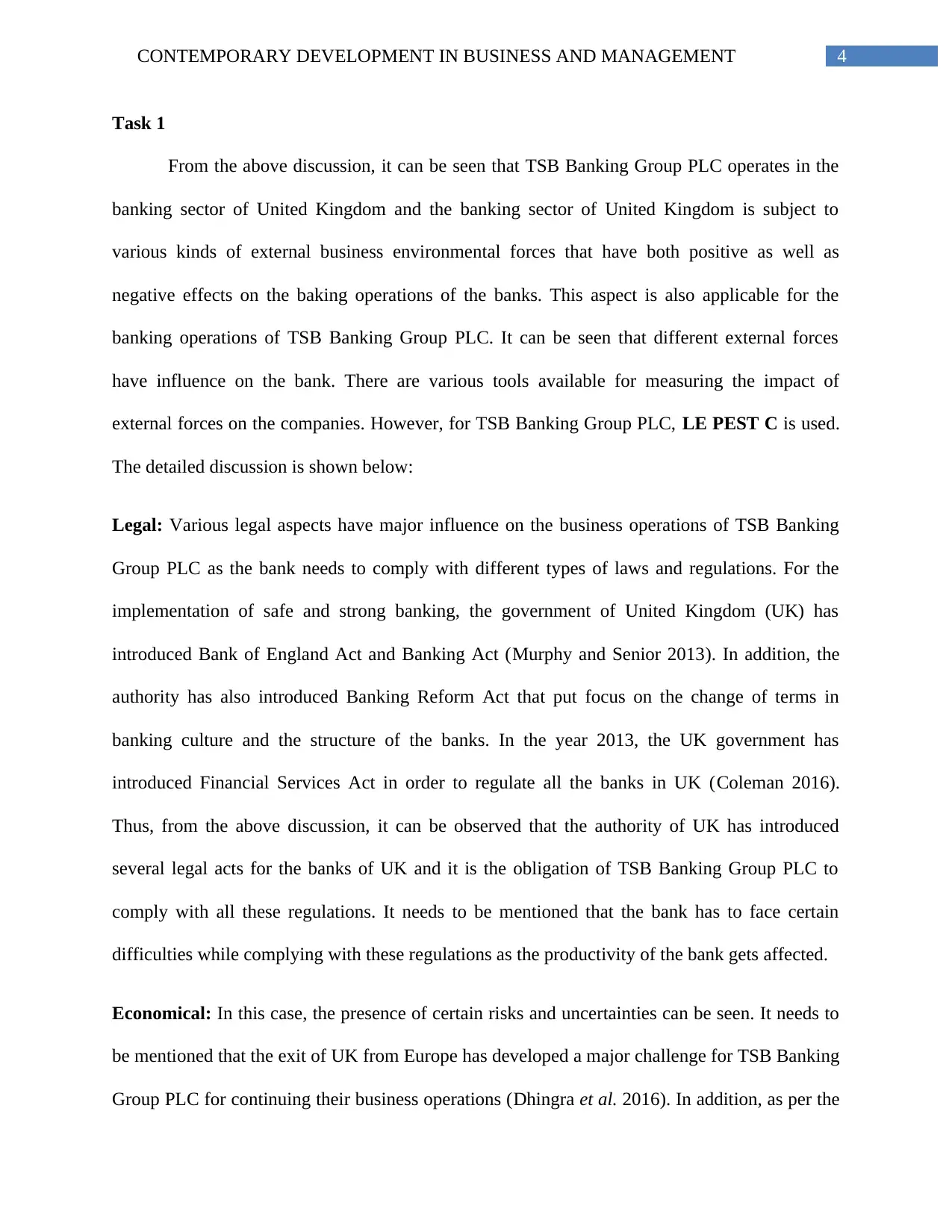
4CONTEMPORARY DEVELOPMENT IN BUSINESS AND MANAGEMENT
Task 1
From the above discussion, it can be seen that TSB Banking Group PLC operates in the
banking sector of United Kingdom and the banking sector of United Kingdom is subject to
various kinds of external business environmental forces that have both positive as well as
negative effects on the baking operations of the banks. This aspect is also applicable for the
banking operations of TSB Banking Group PLC. It can be seen that different external forces
have influence on the bank. There are various tools available for measuring the impact of
external forces on the companies. However, for TSB Banking Group PLC, LE PEST C is used.
The detailed discussion is shown below:
Legal: Various legal aspects have major influence on the business operations of TSB Banking
Group PLC as the bank needs to comply with different types of laws and regulations. For the
implementation of safe and strong banking, the government of United Kingdom (UK) has
introduced Bank of England Act and Banking Act (Murphy and Senior 2013). In addition, the
authority has also introduced Banking Reform Act that put focus on the change of terms in
banking culture and the structure of the banks. In the year 2013, the UK government has
introduced Financial Services Act in order to regulate all the banks in UK (Coleman 2016).
Thus, from the above discussion, it can be observed that the authority of UK has introduced
several legal acts for the banks of UK and it is the obligation of TSB Banking Group PLC to
comply with all these regulations. It needs to be mentioned that the bank has to face certain
difficulties while complying with these regulations as the productivity of the bank gets affected.
Economical: In this case, the presence of certain risks and uncertainties can be seen. It needs to
be mentioned that the exit of UK from Europe has developed a major challenge for TSB Banking
Group PLC for continuing their business operations (Dhingra et al. 2016). In addition, as per the
Task 1
From the above discussion, it can be seen that TSB Banking Group PLC operates in the
banking sector of United Kingdom and the banking sector of United Kingdom is subject to
various kinds of external business environmental forces that have both positive as well as
negative effects on the baking operations of the banks. This aspect is also applicable for the
banking operations of TSB Banking Group PLC. It can be seen that different external forces
have influence on the bank. There are various tools available for measuring the impact of
external forces on the companies. However, for TSB Banking Group PLC, LE PEST C is used.
The detailed discussion is shown below:
Legal: Various legal aspects have major influence on the business operations of TSB Banking
Group PLC as the bank needs to comply with different types of laws and regulations. For the
implementation of safe and strong banking, the government of United Kingdom (UK) has
introduced Bank of England Act and Banking Act (Murphy and Senior 2013). In addition, the
authority has also introduced Banking Reform Act that put focus on the change of terms in
banking culture and the structure of the banks. In the year 2013, the UK government has
introduced Financial Services Act in order to regulate all the banks in UK (Coleman 2016).
Thus, from the above discussion, it can be observed that the authority of UK has introduced
several legal acts for the banks of UK and it is the obligation of TSB Banking Group PLC to
comply with all these regulations. It needs to be mentioned that the bank has to face certain
difficulties while complying with these regulations as the productivity of the bank gets affected.
Economical: In this case, the presence of certain risks and uncertainties can be seen. It needs to
be mentioned that the exit of UK from Europe has developed a major challenge for TSB Banking
Group PLC for continuing their business operations (Dhingra et al. 2016). In addition, as per the
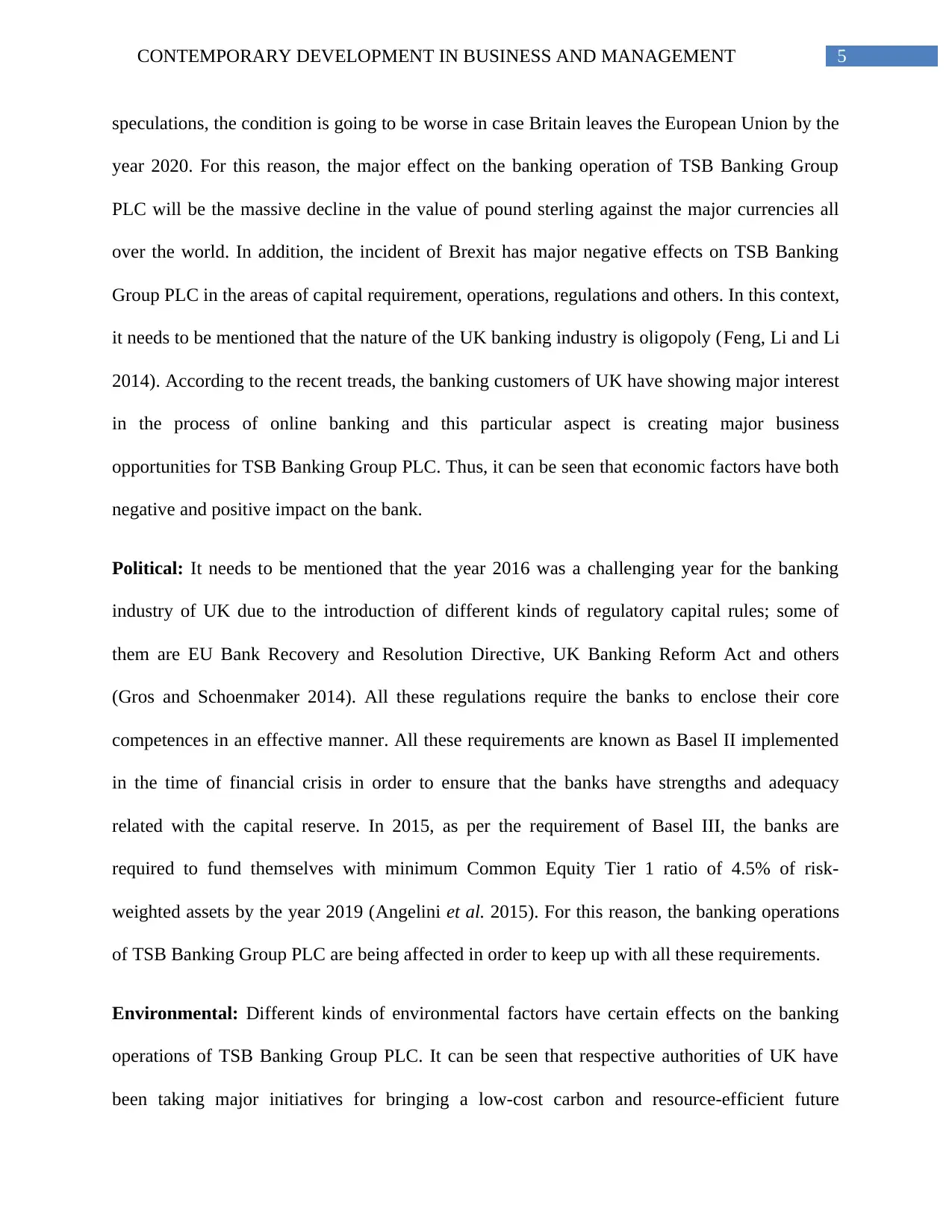
5CONTEMPORARY DEVELOPMENT IN BUSINESS AND MANAGEMENT
speculations, the condition is going to be worse in case Britain leaves the European Union by the
year 2020. For this reason, the major effect on the banking operation of TSB Banking Group
PLC will be the massive decline in the value of pound sterling against the major currencies all
over the world. In addition, the incident of Brexit has major negative effects on TSB Banking
Group PLC in the areas of capital requirement, operations, regulations and others. In this context,
it needs to be mentioned that the nature of the UK banking industry is oligopoly (Feng, Li and Li
2014). According to the recent treads, the banking customers of UK have showing major interest
in the process of online banking and this particular aspect is creating major business
opportunities for TSB Banking Group PLC. Thus, it can be seen that economic factors have both
negative and positive impact on the bank.
Political: It needs to be mentioned that the year 2016 was a challenging year for the banking
industry of UK due to the introduction of different kinds of regulatory capital rules; some of
them are EU Bank Recovery and Resolution Directive, UK Banking Reform Act and others
(Gros and Schoenmaker 2014). All these regulations require the banks to enclose their core
competences in an effective manner. All these requirements are known as Basel II implemented
in the time of financial crisis in order to ensure that the banks have strengths and adequacy
related with the capital reserve. In 2015, as per the requirement of Basel III, the banks are
required to fund themselves with minimum Common Equity Tier 1 ratio of 4.5% of risk-
weighted assets by the year 2019 (Angelini et al. 2015). For this reason, the banking operations
of TSB Banking Group PLC are being affected in order to keep up with all these requirements.
Environmental: Different kinds of environmental factors have certain effects on the banking
operations of TSB Banking Group PLC. It can be seen that respective authorities of UK have
been taking major initiatives for bringing a low-cost carbon and resource-efficient future
speculations, the condition is going to be worse in case Britain leaves the European Union by the
year 2020. For this reason, the major effect on the banking operation of TSB Banking Group
PLC will be the massive decline in the value of pound sterling against the major currencies all
over the world. In addition, the incident of Brexit has major negative effects on TSB Banking
Group PLC in the areas of capital requirement, operations, regulations and others. In this context,
it needs to be mentioned that the nature of the UK banking industry is oligopoly (Feng, Li and Li
2014). According to the recent treads, the banking customers of UK have showing major interest
in the process of online banking and this particular aspect is creating major business
opportunities for TSB Banking Group PLC. Thus, it can be seen that economic factors have both
negative and positive impact on the bank.
Political: It needs to be mentioned that the year 2016 was a challenging year for the banking
industry of UK due to the introduction of different kinds of regulatory capital rules; some of
them are EU Bank Recovery and Resolution Directive, UK Banking Reform Act and others
(Gros and Schoenmaker 2014). All these regulations require the banks to enclose their core
competences in an effective manner. All these requirements are known as Basel II implemented
in the time of financial crisis in order to ensure that the banks have strengths and adequacy
related with the capital reserve. In 2015, as per the requirement of Basel III, the banks are
required to fund themselves with minimum Common Equity Tier 1 ratio of 4.5% of risk-
weighted assets by the year 2019 (Angelini et al. 2015). For this reason, the banking operations
of TSB Banking Group PLC are being affected in order to keep up with all these requirements.
Environmental: Different kinds of environmental factors have certain effects on the banking
operations of TSB Banking Group PLC. It can be seen that respective authorities of UK have
been taking major initiatives for bringing a low-cost carbon and resource-efficient future
⊘ This is a preview!⊘
Do you want full access?
Subscribe today to unlock all pages.

Trusted by 1+ million students worldwide
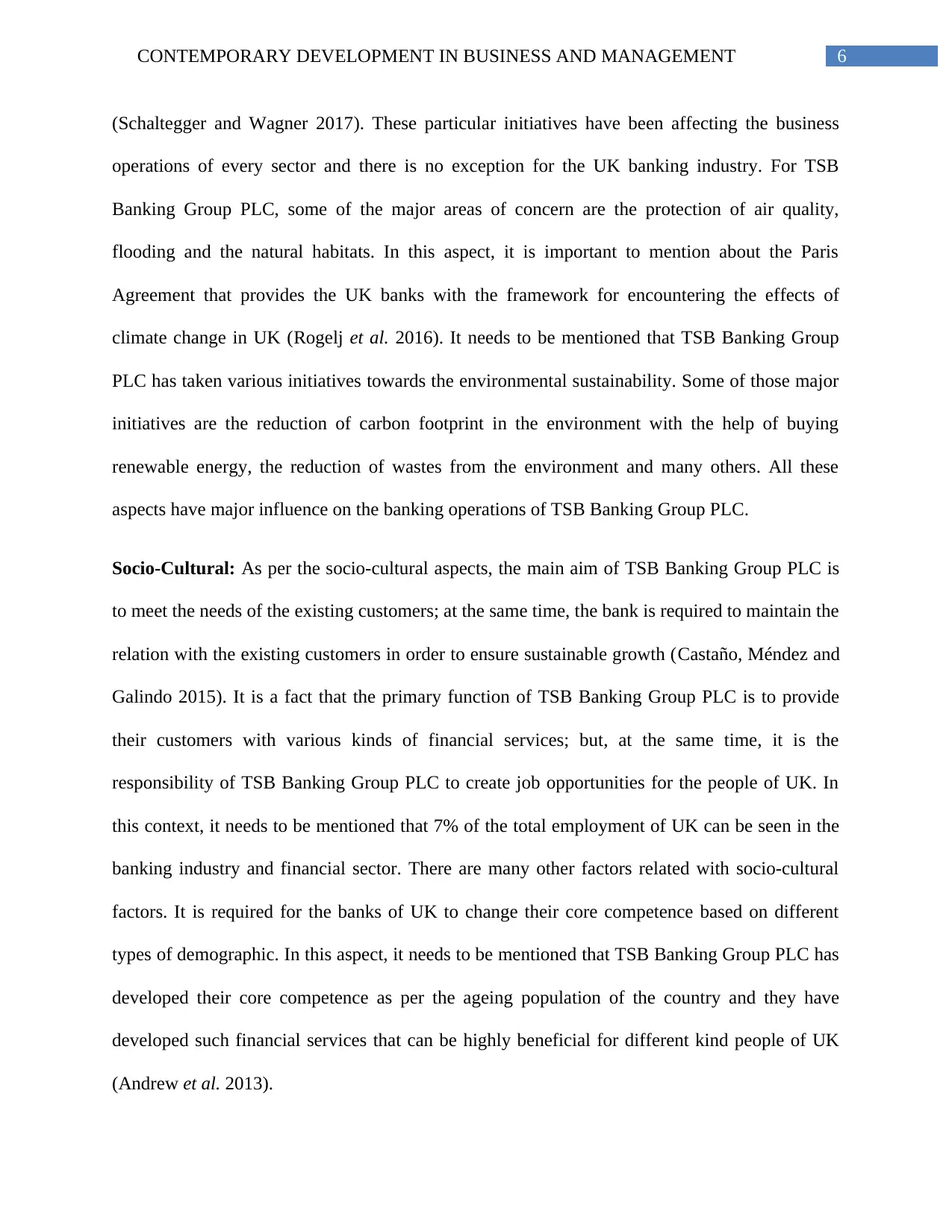
6CONTEMPORARY DEVELOPMENT IN BUSINESS AND MANAGEMENT
(Schaltegger and Wagner 2017). These particular initiatives have been affecting the business
operations of every sector and there is no exception for the UK banking industry. For TSB
Banking Group PLC, some of the major areas of concern are the protection of air quality,
flooding and the natural habitats. In this aspect, it is important to mention about the Paris
Agreement that provides the UK banks with the framework for encountering the effects of
climate change in UK (Rogelj et al. 2016). It needs to be mentioned that TSB Banking Group
PLC has taken various initiatives towards the environmental sustainability. Some of those major
initiatives are the reduction of carbon footprint in the environment with the help of buying
renewable energy, the reduction of wastes from the environment and many others. All these
aspects have major influence on the banking operations of TSB Banking Group PLC.
Socio-Cultural: As per the socio-cultural aspects, the main aim of TSB Banking Group PLC is
to meet the needs of the existing customers; at the same time, the bank is required to maintain the
relation with the existing customers in order to ensure sustainable growth (Castaño, Méndez and
Galindo 2015). It is a fact that the primary function of TSB Banking Group PLC is to provide
their customers with various kinds of financial services; but, at the same time, it is the
responsibility of TSB Banking Group PLC to create job opportunities for the people of UK. In
this context, it needs to be mentioned that 7% of the total employment of UK can be seen in the
banking industry and financial sector. There are many other factors related with socio-cultural
factors. It is required for the banks of UK to change their core competence based on different
types of demographic. In this aspect, it needs to be mentioned that TSB Banking Group PLC has
developed their core competence as per the ageing population of the country and they have
developed such financial services that can be highly beneficial for different kind people of UK
(Andrew et al. 2013).
(Schaltegger and Wagner 2017). These particular initiatives have been affecting the business
operations of every sector and there is no exception for the UK banking industry. For TSB
Banking Group PLC, some of the major areas of concern are the protection of air quality,
flooding and the natural habitats. In this aspect, it is important to mention about the Paris
Agreement that provides the UK banks with the framework for encountering the effects of
climate change in UK (Rogelj et al. 2016). It needs to be mentioned that TSB Banking Group
PLC has taken various initiatives towards the environmental sustainability. Some of those major
initiatives are the reduction of carbon footprint in the environment with the help of buying
renewable energy, the reduction of wastes from the environment and many others. All these
aspects have major influence on the banking operations of TSB Banking Group PLC.
Socio-Cultural: As per the socio-cultural aspects, the main aim of TSB Banking Group PLC is
to meet the needs of the existing customers; at the same time, the bank is required to maintain the
relation with the existing customers in order to ensure sustainable growth (Castaño, Méndez and
Galindo 2015). It is a fact that the primary function of TSB Banking Group PLC is to provide
their customers with various kinds of financial services; but, at the same time, it is the
responsibility of TSB Banking Group PLC to create job opportunities for the people of UK. In
this context, it needs to be mentioned that 7% of the total employment of UK can be seen in the
banking industry and financial sector. There are many other factors related with socio-cultural
factors. It is required for the banks of UK to change their core competence based on different
types of demographic. In this aspect, it needs to be mentioned that TSB Banking Group PLC has
developed their core competence as per the ageing population of the country and they have
developed such financial services that can be highly beneficial for different kind people of UK
(Andrew et al. 2013).
Paraphrase This Document
Need a fresh take? Get an instant paraphrase of this document with our AI Paraphraser
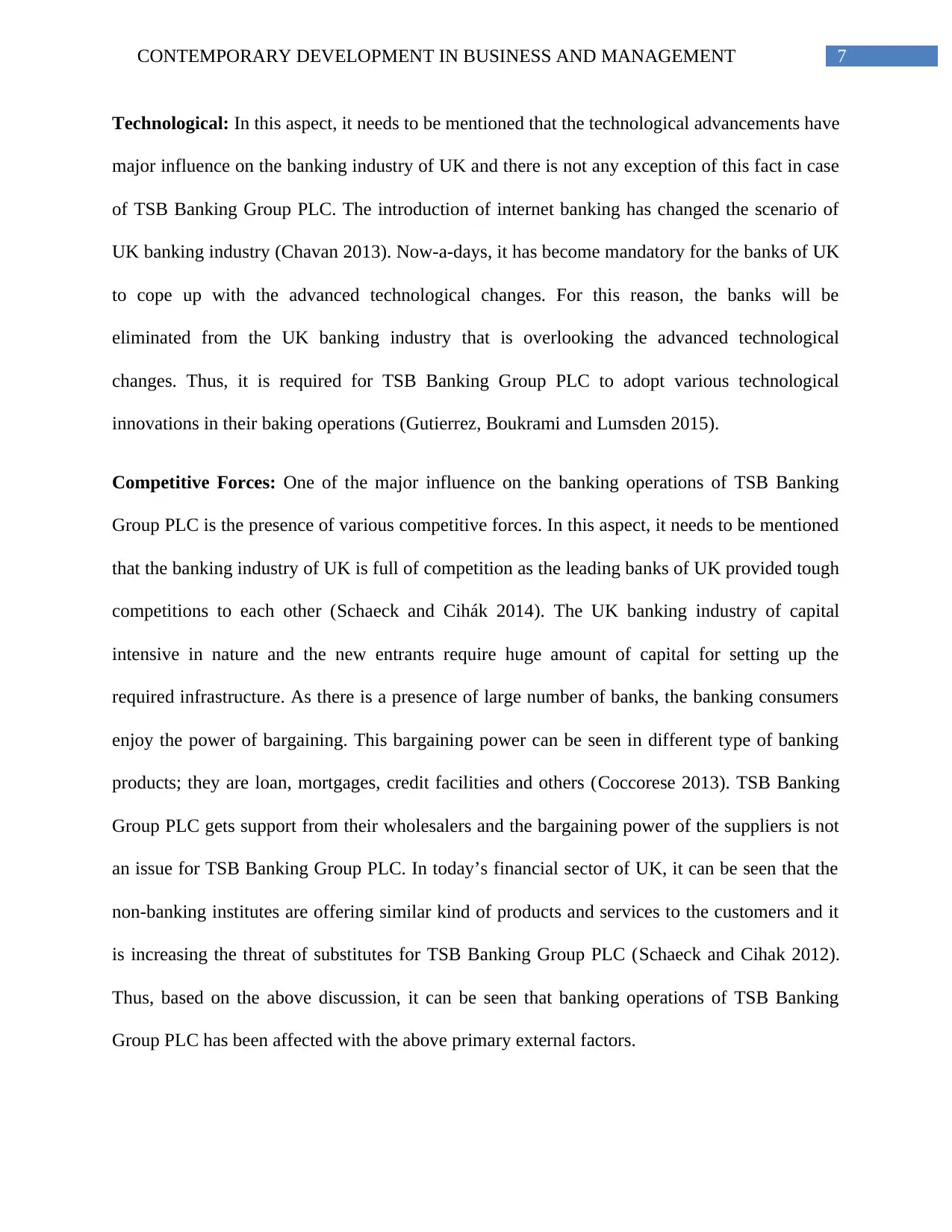
7CONTEMPORARY DEVELOPMENT IN BUSINESS AND MANAGEMENT
Technological: In this aspect, it needs to be mentioned that the technological advancements have
major influence on the banking industry of UK and there is not any exception of this fact in case
of TSB Banking Group PLC. The introduction of internet banking has changed the scenario of
UK banking industry (Chavan 2013). Now-a-days, it has become mandatory for the banks of UK
to cope up with the advanced technological changes. For this reason, the banks will be
eliminated from the UK banking industry that is overlooking the advanced technological
changes. Thus, it is required for TSB Banking Group PLC to adopt various technological
innovations in their baking operations (Gutierrez, Boukrami and Lumsden 2015).
Competitive Forces: One of the major influence on the banking operations of TSB Banking
Group PLC is the presence of various competitive forces. In this aspect, it needs to be mentioned
that the banking industry of UK is full of competition as the leading banks of UK provided tough
competitions to each other (Schaeck and Cihák 2014). The UK banking industry of capital
intensive in nature and the new entrants require huge amount of capital for setting up the
required infrastructure. As there is a presence of large number of banks, the banking consumers
enjoy the power of bargaining. This bargaining power can be seen in different type of banking
products; they are loan, mortgages, credit facilities and others (Coccorese 2013). TSB Banking
Group PLC gets support from their wholesalers and the bargaining power of the suppliers is not
an issue for TSB Banking Group PLC. In today’s financial sector of UK, it can be seen that the
non-banking institutes are offering similar kind of products and services to the customers and it
is increasing the threat of substitutes for TSB Banking Group PLC (Schaeck and Cihak 2012).
Thus, based on the above discussion, it can be seen that banking operations of TSB Banking
Group PLC has been affected with the above primary external factors.
Technological: In this aspect, it needs to be mentioned that the technological advancements have
major influence on the banking industry of UK and there is not any exception of this fact in case
of TSB Banking Group PLC. The introduction of internet banking has changed the scenario of
UK banking industry (Chavan 2013). Now-a-days, it has become mandatory for the banks of UK
to cope up with the advanced technological changes. For this reason, the banks will be
eliminated from the UK banking industry that is overlooking the advanced technological
changes. Thus, it is required for TSB Banking Group PLC to adopt various technological
innovations in their baking operations (Gutierrez, Boukrami and Lumsden 2015).
Competitive Forces: One of the major influence on the banking operations of TSB Banking
Group PLC is the presence of various competitive forces. In this aspect, it needs to be mentioned
that the banking industry of UK is full of competition as the leading banks of UK provided tough
competitions to each other (Schaeck and Cihák 2014). The UK banking industry of capital
intensive in nature and the new entrants require huge amount of capital for setting up the
required infrastructure. As there is a presence of large number of banks, the banking consumers
enjoy the power of bargaining. This bargaining power can be seen in different type of banking
products; they are loan, mortgages, credit facilities and others (Coccorese 2013). TSB Banking
Group PLC gets support from their wholesalers and the bargaining power of the suppliers is not
an issue for TSB Banking Group PLC. In today’s financial sector of UK, it can be seen that the
non-banking institutes are offering similar kind of products and services to the customers and it
is increasing the threat of substitutes for TSB Banking Group PLC (Schaeck and Cihak 2012).
Thus, based on the above discussion, it can be seen that banking operations of TSB Banking
Group PLC has been affected with the above primary external factors.
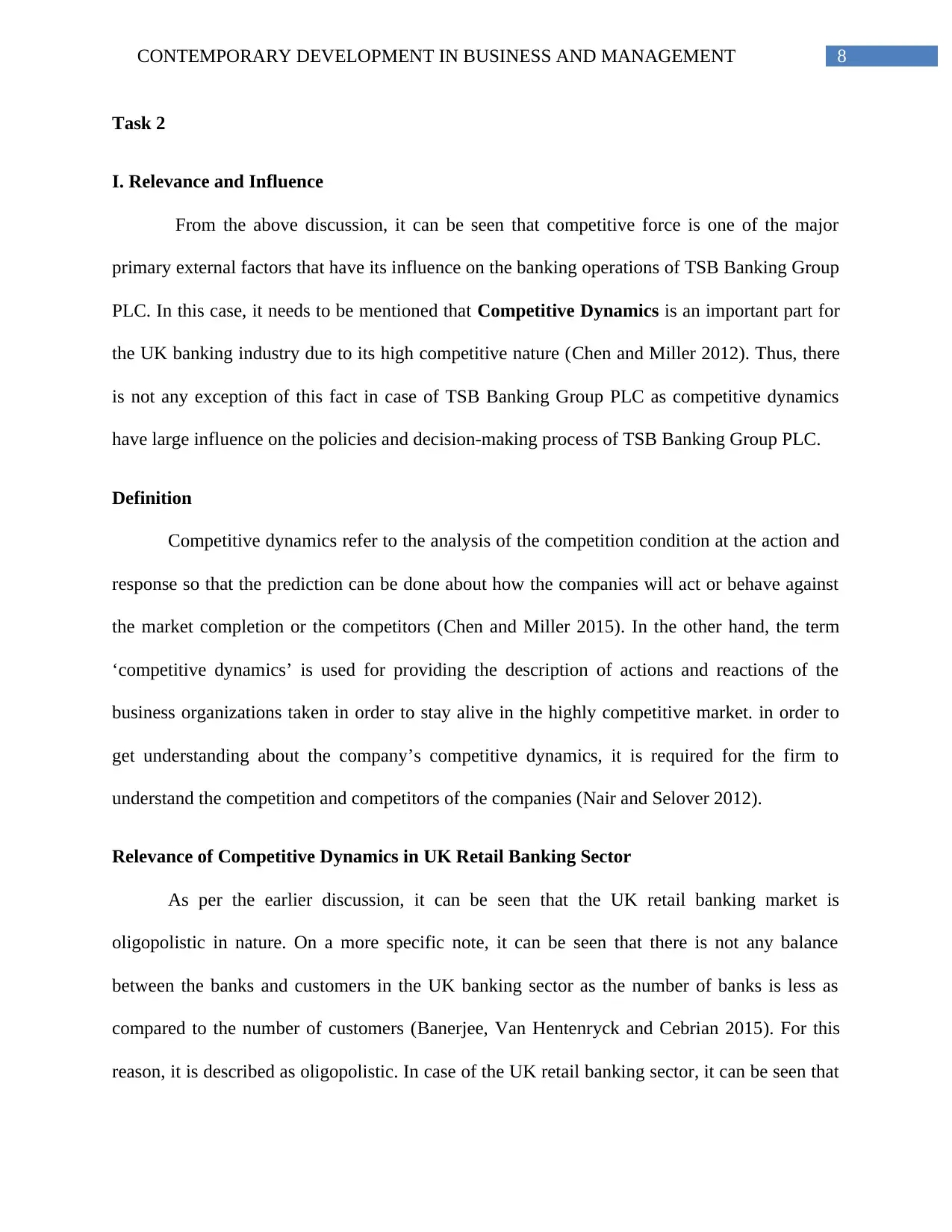
8CONTEMPORARY DEVELOPMENT IN BUSINESS AND MANAGEMENT
Task 2
I. Relevance and Influence
From the above discussion, it can be seen that competitive force is one of the major
primary external factors that have its influence on the banking operations of TSB Banking Group
PLC. In this case, it needs to be mentioned that Competitive Dynamics is an important part for
the UK banking industry due to its high competitive nature (Chen and Miller 2012). Thus, there
is not any exception of this fact in case of TSB Banking Group PLC as competitive dynamics
have large influence on the policies and decision-making process of TSB Banking Group PLC.
Definition
Competitive dynamics refer to the analysis of the competition condition at the action and
response so that the prediction can be done about how the companies will act or behave against
the market completion or the competitors (Chen and Miller 2015). In the other hand, the term
‘competitive dynamics’ is used for providing the description of actions and reactions of the
business organizations taken in order to stay alive in the highly competitive market. in order to
get understanding about the company’s competitive dynamics, it is required for the firm to
understand the competition and competitors of the companies (Nair and Selover 2012).
Relevance of Competitive Dynamics in UK Retail Banking Sector
As per the earlier discussion, it can be seen that the UK retail banking market is
oligopolistic in nature. On a more specific note, it can be seen that there is not any balance
between the banks and customers in the UK banking sector as the number of banks is less as
compared to the number of customers (Banerjee, Van Hentenryck and Cebrian 2015). For this
reason, it is described as oligopolistic. In case of the UK retail banking sector, it can be seen that
Task 2
I. Relevance and Influence
From the above discussion, it can be seen that competitive force is one of the major
primary external factors that have its influence on the banking operations of TSB Banking Group
PLC. In this case, it needs to be mentioned that Competitive Dynamics is an important part for
the UK banking industry due to its high competitive nature (Chen and Miller 2012). Thus, there
is not any exception of this fact in case of TSB Banking Group PLC as competitive dynamics
have large influence on the policies and decision-making process of TSB Banking Group PLC.
Definition
Competitive dynamics refer to the analysis of the competition condition at the action and
response so that the prediction can be done about how the companies will act or behave against
the market completion or the competitors (Chen and Miller 2015). In the other hand, the term
‘competitive dynamics’ is used for providing the description of actions and reactions of the
business organizations taken in order to stay alive in the highly competitive market. in order to
get understanding about the company’s competitive dynamics, it is required for the firm to
understand the competition and competitors of the companies (Nair and Selover 2012).
Relevance of Competitive Dynamics in UK Retail Banking Sector
As per the earlier discussion, it can be seen that the UK retail banking market is
oligopolistic in nature. On a more specific note, it can be seen that there is not any balance
between the banks and customers in the UK banking sector as the number of banks is less as
compared to the number of customers (Banerjee, Van Hentenryck and Cebrian 2015). For this
reason, it is described as oligopolistic. In case of the UK retail banking sector, it can be seen that
⊘ This is a preview!⊘
Do you want full access?
Subscribe today to unlock all pages.

Trusted by 1+ million students worldwide
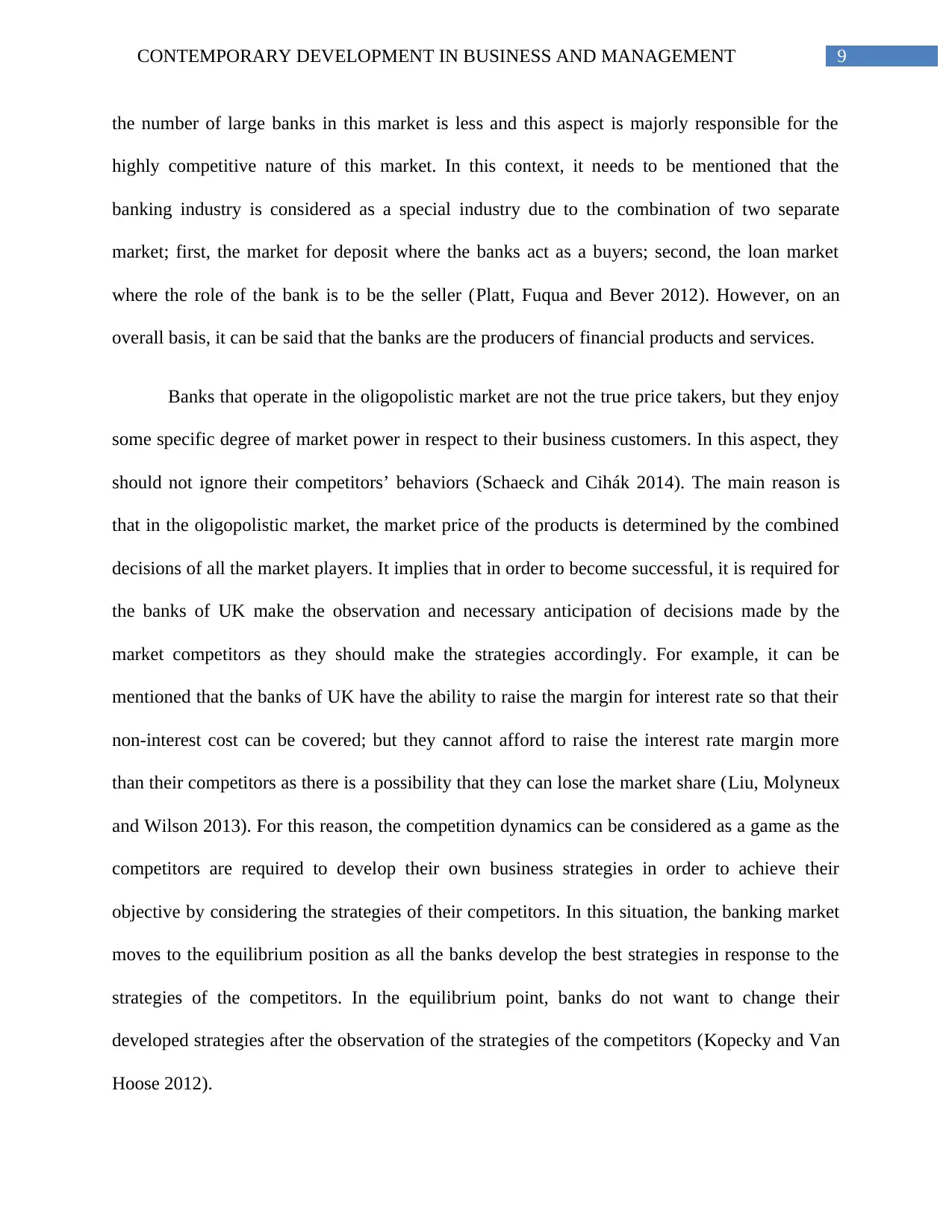
9CONTEMPORARY DEVELOPMENT IN BUSINESS AND MANAGEMENT
the number of large banks in this market is less and this aspect is majorly responsible for the
highly competitive nature of this market. In this context, it needs to be mentioned that the
banking industry is considered as a special industry due to the combination of two separate
market; first, the market for deposit where the banks act as a buyers; second, the loan market
where the role of the bank is to be the seller (Platt, Fuqua and Bever 2012). However, on an
overall basis, it can be said that the banks are the producers of financial products and services.
Banks that operate in the oligopolistic market are not the true price takers, but they enjoy
some specific degree of market power in respect to their business customers. In this aspect, they
should not ignore their competitors’ behaviors (Schaeck and Cihák 2014). The main reason is
that in the oligopolistic market, the market price of the products is determined by the combined
decisions of all the market players. It implies that in order to become successful, it is required for
the banks of UK make the observation and necessary anticipation of decisions made by the
market competitors as they should make the strategies accordingly. For example, it can be
mentioned that the banks of UK have the ability to raise the margin for interest rate so that their
non-interest cost can be covered; but they cannot afford to raise the interest rate margin more
than their competitors as there is a possibility that they can lose the market share (Liu, Molyneux
and Wilson 2013). For this reason, the competition dynamics can be considered as a game as the
competitors are required to develop their own business strategies in order to achieve their
objective by considering the strategies of their competitors. In this situation, the banking market
moves to the equilibrium position as all the banks develop the best strategies in response to the
strategies of the competitors. In the equilibrium point, banks do not want to change their
developed strategies after the observation of the strategies of the competitors (Kopecky and Van
Hoose 2012).
the number of large banks in this market is less and this aspect is majorly responsible for the
highly competitive nature of this market. In this context, it needs to be mentioned that the
banking industry is considered as a special industry due to the combination of two separate
market; first, the market for deposit where the banks act as a buyers; second, the loan market
where the role of the bank is to be the seller (Platt, Fuqua and Bever 2012). However, on an
overall basis, it can be said that the banks are the producers of financial products and services.
Banks that operate in the oligopolistic market are not the true price takers, but they enjoy
some specific degree of market power in respect to their business customers. In this aspect, they
should not ignore their competitors’ behaviors (Schaeck and Cihák 2014). The main reason is
that in the oligopolistic market, the market price of the products is determined by the combined
decisions of all the market players. It implies that in order to become successful, it is required for
the banks of UK make the observation and necessary anticipation of decisions made by the
market competitors as they should make the strategies accordingly. For example, it can be
mentioned that the banks of UK have the ability to raise the margin for interest rate so that their
non-interest cost can be covered; but they cannot afford to raise the interest rate margin more
than their competitors as there is a possibility that they can lose the market share (Liu, Molyneux
and Wilson 2013). For this reason, the competition dynamics can be considered as a game as the
competitors are required to develop their own business strategies in order to achieve their
objective by considering the strategies of their competitors. In this situation, the banking market
moves to the equilibrium position as all the banks develop the best strategies in response to the
strategies of the competitors. In the equilibrium point, banks do not want to change their
developed strategies after the observation of the strategies of the competitors (Kopecky and Van
Hoose 2012).
Paraphrase This Document
Need a fresh take? Get an instant paraphrase of this document with our AI Paraphraser
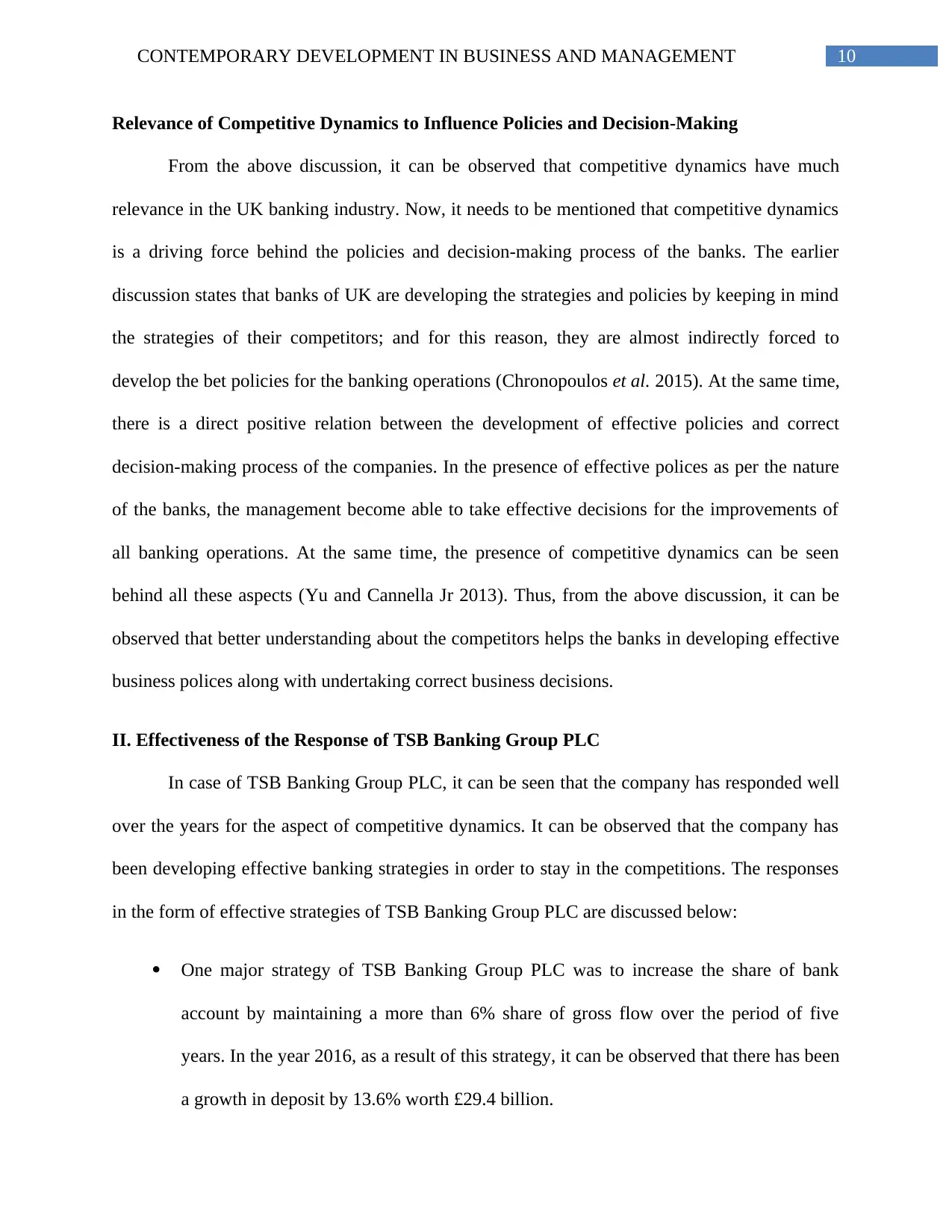
10CONTEMPORARY DEVELOPMENT IN BUSINESS AND MANAGEMENT
Relevance of Competitive Dynamics to Influence Policies and Decision-Making
From the above discussion, it can be observed that competitive dynamics have much
relevance in the UK banking industry. Now, it needs to be mentioned that competitive dynamics
is a driving force behind the policies and decision-making process of the banks. The earlier
discussion states that banks of UK are developing the strategies and policies by keeping in mind
the strategies of their competitors; and for this reason, they are almost indirectly forced to
develop the bet policies for the banking operations (Chronopoulos et al. 2015). At the same time,
there is a direct positive relation between the development of effective policies and correct
decision-making process of the companies. In the presence of effective polices as per the nature
of the banks, the management become able to take effective decisions for the improvements of
all banking operations. At the same time, the presence of competitive dynamics can be seen
behind all these aspects (Yu and Cannella Jr 2013). Thus, from the above discussion, it can be
observed that better understanding about the competitors helps the banks in developing effective
business polices along with undertaking correct business decisions.
II. Effectiveness of the Response of TSB Banking Group PLC
In case of TSB Banking Group PLC, it can be seen that the company has responded well
over the years for the aspect of competitive dynamics. It can be observed that the company has
been developing effective banking strategies in order to stay in the competitions. The responses
in the form of effective strategies of TSB Banking Group PLC are discussed below:
One major strategy of TSB Banking Group PLC was to increase the share of bank
account by maintaining a more than 6% share of gross flow over the period of five
years. In the year 2016, as a result of this strategy, it can be observed that there has been
a growth in deposit by 13.6% worth £29.4 billion.
Relevance of Competitive Dynamics to Influence Policies and Decision-Making
From the above discussion, it can be observed that competitive dynamics have much
relevance in the UK banking industry. Now, it needs to be mentioned that competitive dynamics
is a driving force behind the policies and decision-making process of the banks. The earlier
discussion states that banks of UK are developing the strategies and policies by keeping in mind
the strategies of their competitors; and for this reason, they are almost indirectly forced to
develop the bet policies for the banking operations (Chronopoulos et al. 2015). At the same time,
there is a direct positive relation between the development of effective policies and correct
decision-making process of the companies. In the presence of effective polices as per the nature
of the banks, the management become able to take effective decisions for the improvements of
all banking operations. At the same time, the presence of competitive dynamics can be seen
behind all these aspects (Yu and Cannella Jr 2013). Thus, from the above discussion, it can be
observed that better understanding about the competitors helps the banks in developing effective
business polices along with undertaking correct business decisions.
II. Effectiveness of the Response of TSB Banking Group PLC
In case of TSB Banking Group PLC, it can be seen that the company has responded well
over the years for the aspect of competitive dynamics. It can be observed that the company has
been developing effective banking strategies in order to stay in the competitions. The responses
in the form of effective strategies of TSB Banking Group PLC are discussed below:
One major strategy of TSB Banking Group PLC was to increase the share of bank
account by maintaining a more than 6% share of gross flow over the period of five
years. In the year 2016, as a result of this strategy, it can be observed that there has been
a growth in deposit by 13.6% worth £29.4 billion.
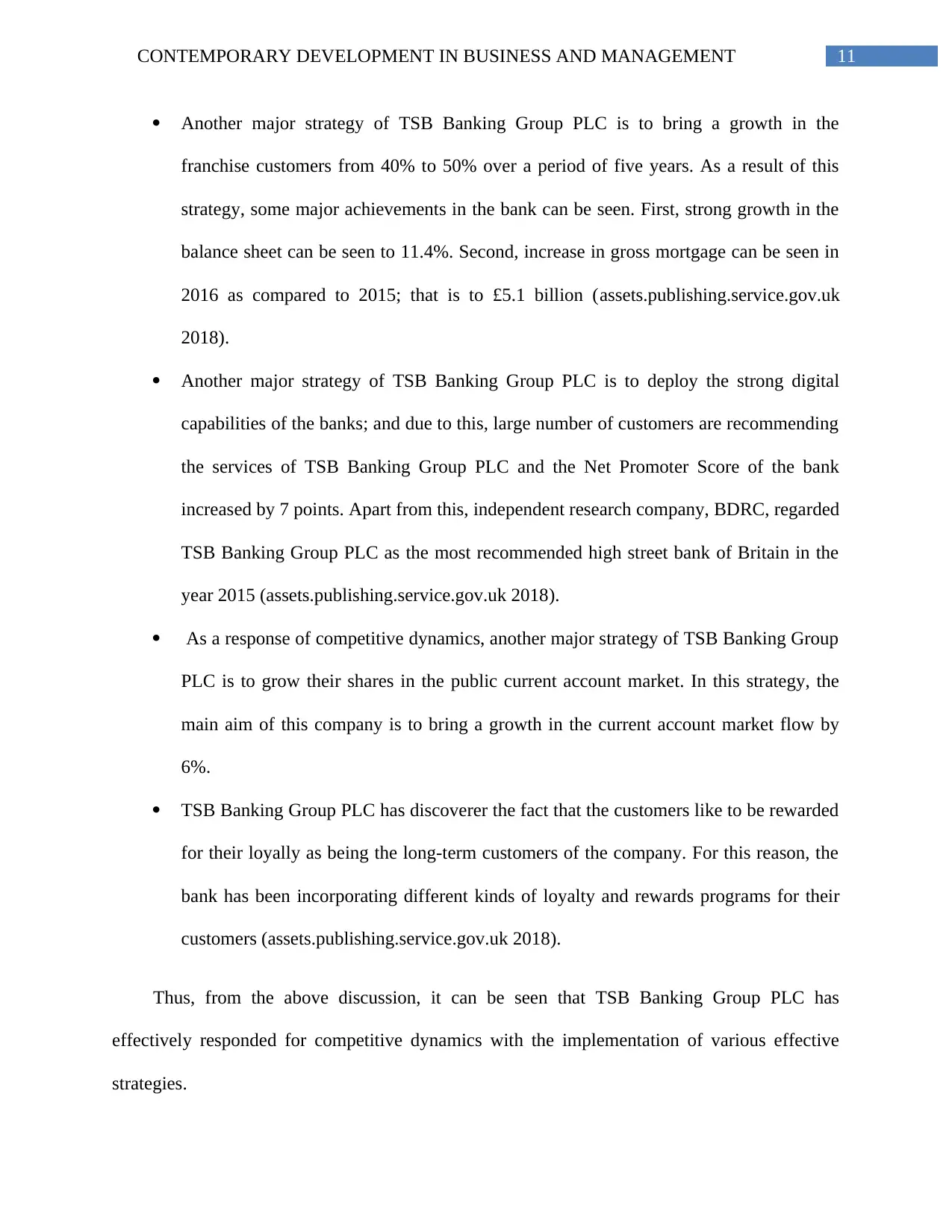
11CONTEMPORARY DEVELOPMENT IN BUSINESS AND MANAGEMENT
Another major strategy of TSB Banking Group PLC is to bring a growth in the
franchise customers from 40% to 50% over a period of five years. As a result of this
strategy, some major achievements in the bank can be seen. First, strong growth in the
balance sheet can be seen to 11.4%. Second, increase in gross mortgage can be seen in
2016 as compared to 2015; that is to £5.1 billion (assets.publishing.service.gov.uk
2018).
Another major strategy of TSB Banking Group PLC is to deploy the strong digital
capabilities of the banks; and due to this, large number of customers are recommending
the services of TSB Banking Group PLC and the Net Promoter Score of the bank
increased by 7 points. Apart from this, independent research company, BDRC, regarded
TSB Banking Group PLC as the most recommended high street bank of Britain in the
year 2015 (assets.publishing.service.gov.uk 2018).
As a response of competitive dynamics, another major strategy of TSB Banking Group
PLC is to grow their shares in the public current account market. In this strategy, the
main aim of this company is to bring a growth in the current account market flow by
6%.
TSB Banking Group PLC has discoverer the fact that the customers like to be rewarded
for their loyally as being the long-term customers of the company. For this reason, the
bank has been incorporating different kinds of loyalty and rewards programs for their
customers (assets.publishing.service.gov.uk 2018).
Thus, from the above discussion, it can be seen that TSB Banking Group PLC has
effectively responded for competitive dynamics with the implementation of various effective
strategies.
Another major strategy of TSB Banking Group PLC is to bring a growth in the
franchise customers from 40% to 50% over a period of five years. As a result of this
strategy, some major achievements in the bank can be seen. First, strong growth in the
balance sheet can be seen to 11.4%. Second, increase in gross mortgage can be seen in
2016 as compared to 2015; that is to £5.1 billion (assets.publishing.service.gov.uk
2018).
Another major strategy of TSB Banking Group PLC is to deploy the strong digital
capabilities of the banks; and due to this, large number of customers are recommending
the services of TSB Banking Group PLC and the Net Promoter Score of the bank
increased by 7 points. Apart from this, independent research company, BDRC, regarded
TSB Banking Group PLC as the most recommended high street bank of Britain in the
year 2015 (assets.publishing.service.gov.uk 2018).
As a response of competitive dynamics, another major strategy of TSB Banking Group
PLC is to grow their shares in the public current account market. In this strategy, the
main aim of this company is to bring a growth in the current account market flow by
6%.
TSB Banking Group PLC has discoverer the fact that the customers like to be rewarded
for their loyally as being the long-term customers of the company. For this reason, the
bank has been incorporating different kinds of loyalty and rewards programs for their
customers (assets.publishing.service.gov.uk 2018).
Thus, from the above discussion, it can be seen that TSB Banking Group PLC has
effectively responded for competitive dynamics with the implementation of various effective
strategies.
⊘ This is a preview!⊘
Do you want full access?
Subscribe today to unlock all pages.

Trusted by 1+ million students worldwide
1 out of 19
Related Documents
Your All-in-One AI-Powered Toolkit for Academic Success.
+13062052269
info@desklib.com
Available 24*7 on WhatsApp / Email
![[object Object]](/_next/static/media/star-bottom.7253800d.svg)
Unlock your academic potential
Copyright © 2020–2025 A2Z Services. All Rights Reserved. Developed and managed by ZUCOL.





